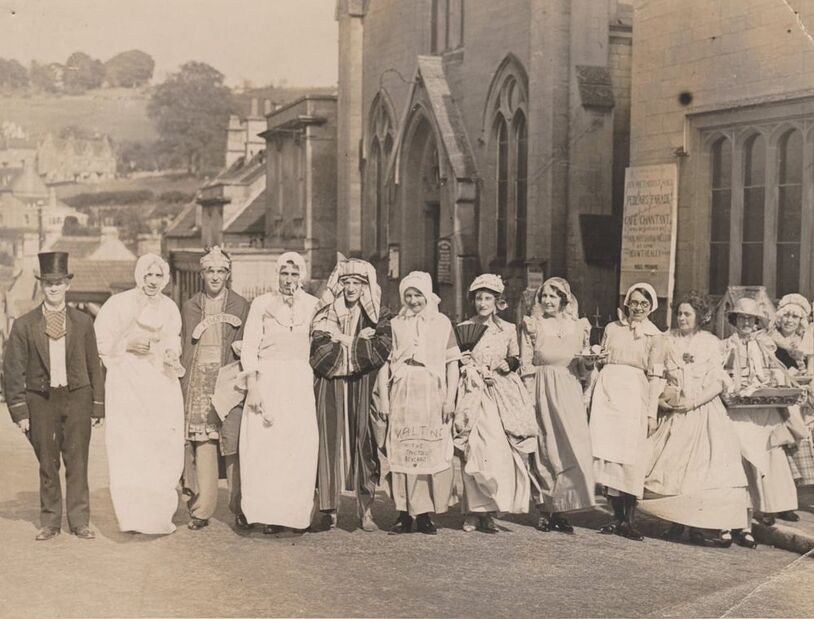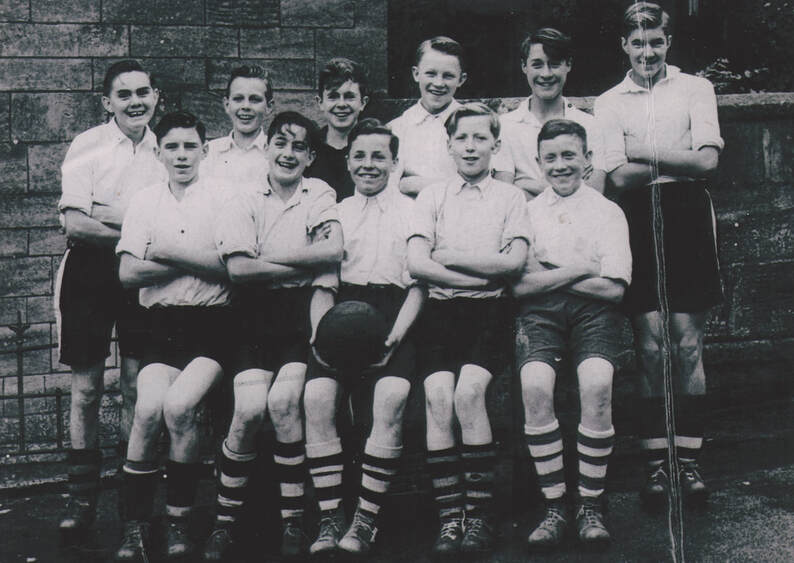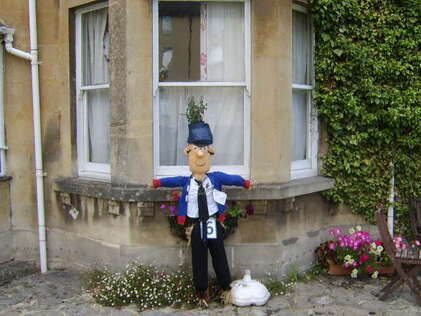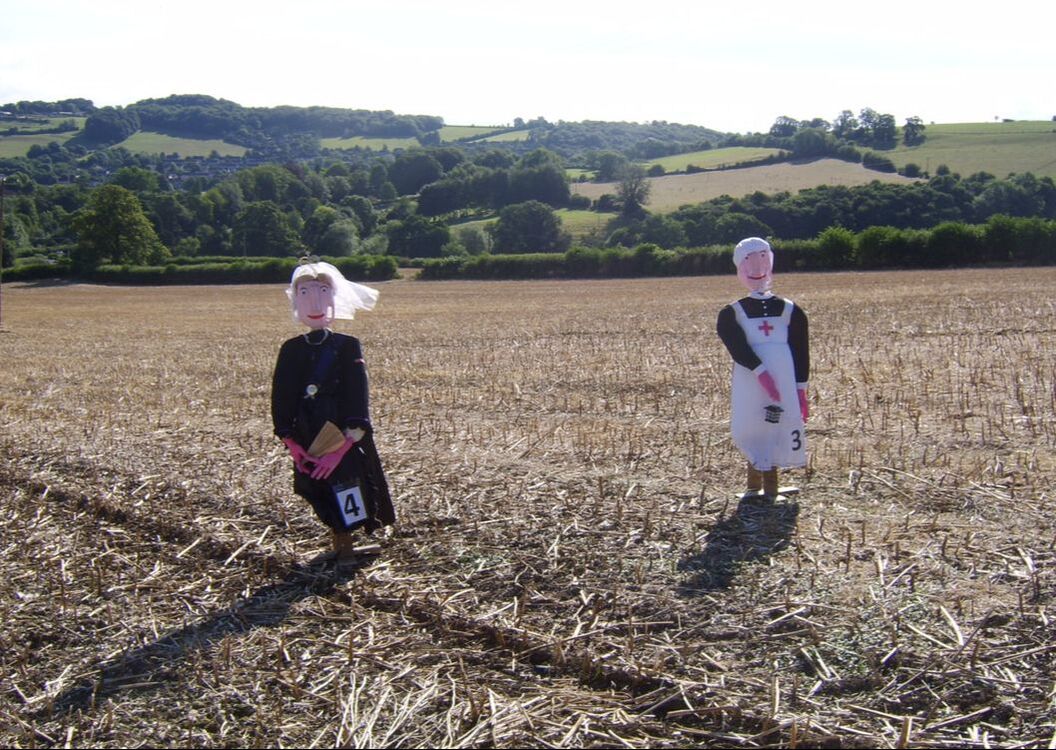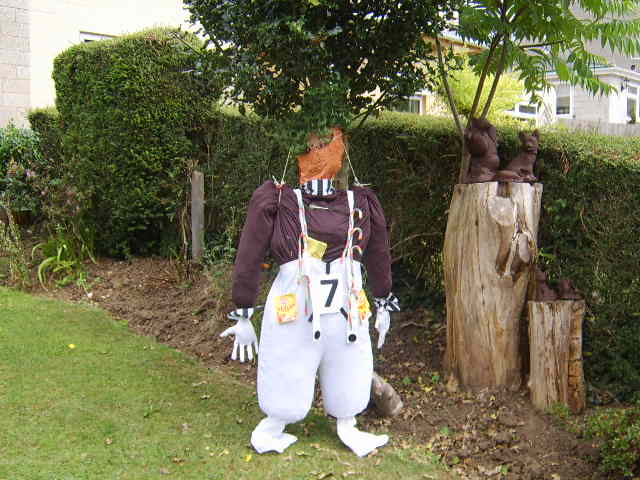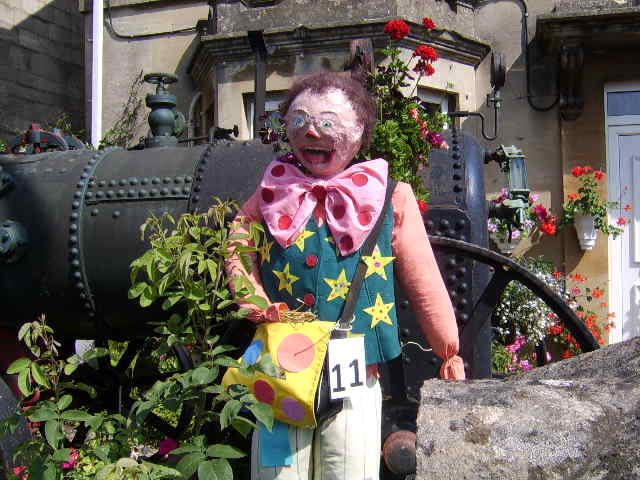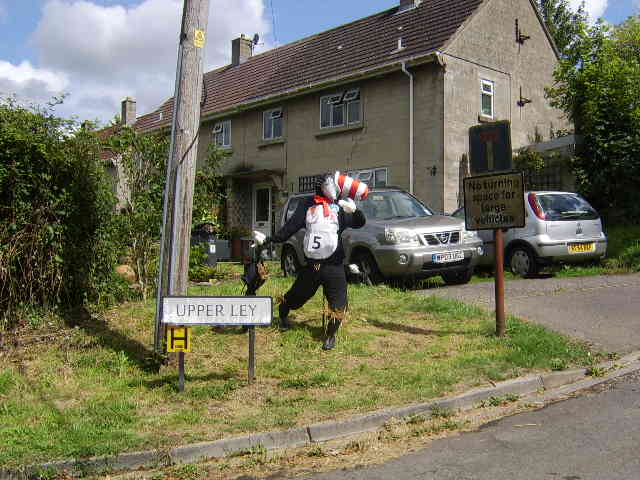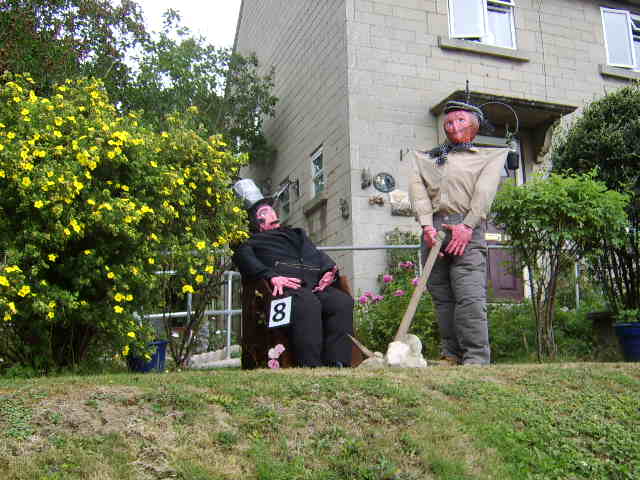Methodist Hall Frivolity Alan Payne September 2021
You might think that the congregation of the Methodist Church was a deeply serious assembly because of the importance of its work to save souls. But this image shows another side to the Box Methodist Church, who manage to mix faith with frivolity. One of the earliest proponents of the outreach mission was Edwin Bow from Valens Terrace. Every Christmas time between 1913 and 1938, he led a party of carol singers travelling throughout the village and outlying hamlets by horse-drawn carriage and on foot to raise money for the National Children's Home and Orphanage and Dr Barnardo's Home.[2] He later talked about how the roads… were not kept in such a good condition as now and parties had been known to return home having left their footwear in the accumulations of mud.[3] The tradition continued after Edwin’s death.[4]
Fetes and Fairs
The cost of building the new Methodist chapel in 1897 and the schoolroom in 1906, had incurred a considerable debt for the church. To reduce the amount owed, the church held an annual fête, usually taking place out of doors on land offered by local supporters. The Bath Silver Band of the Salvation Army were often engaged to enliven proceedings and sports and stalls were the normal activities.[5] At times, the Bath People’s Mission Band (a breakaway group from the Salvation Army) were enlisted.[6]
The event was often held in a field at Townsend, kindly lent by Mr Clarke. The field was never named but it probably was close to the area where the council houses have now been built at Hazelbury Hill.[7] The village celebrations of 1935 to commemorate the Silver Anniversary of King George V were on a larger scale than anything seen since the wartime armistice. An extensive procession was arranged around the village involving many youth organisations and scenes depicting the crowning of the Queen of the Revels took place in the Recreation Field. In 1937 the church applied to the parish council for permission to hold the fete on The Rec in the area where the car park now exists. It was objected to on the grounds that Church (of England) people had never held a fete there .. and there were likely to be cycle races, coconut shies and the like (Mr Shaw Mellor).[8] Of course, the Recreation Field was still very new at that time (donated to Box in 1925) but it was hardly a community gesture.
The needs of the church did not detract from other charity fundraising events organised by the Methodist Church. In 1937 Oswald Butt organised a gypsy fair to be held, a somewhat novel display for Box.[9] It was a large effort, on this occasion trying to raise £300 for the Royal United Hospital, Bath, and attracted Church of England and Methodist representatives from Bath and Box areas. The event was opened by Mrs Shaw Mellor of Box House and had the usual types of stalls selling needlework, sweets, books and lucky dip and a gypsy concert in the evening.
The cost of building the new Methodist chapel in 1897 and the schoolroom in 1906, had incurred a considerable debt for the church. To reduce the amount owed, the church held an annual fête, usually taking place out of doors on land offered by local supporters. The Bath Silver Band of the Salvation Army were often engaged to enliven proceedings and sports and stalls were the normal activities.[5] At times, the Bath People’s Mission Band (a breakaway group from the Salvation Army) were enlisted.[6]
The event was often held in a field at Townsend, kindly lent by Mr Clarke. The field was never named but it probably was close to the area where the council houses have now been built at Hazelbury Hill.[7] The village celebrations of 1935 to commemorate the Silver Anniversary of King George V were on a larger scale than anything seen since the wartime armistice. An extensive procession was arranged around the village involving many youth organisations and scenes depicting the crowning of the Queen of the Revels took place in the Recreation Field. In 1937 the church applied to the parish council for permission to hold the fete on The Rec in the area where the car park now exists. It was objected to on the grounds that Church (of England) people had never held a fete there .. and there were likely to be cycle races, coconut shies and the like (Mr Shaw Mellor).[8] Of course, the Recreation Field was still very new at that time (donated to Box in 1925) but it was hardly a community gesture.
The needs of the church did not detract from other charity fundraising events organised by the Methodist Church. In 1937 Oswald Butt organised a gypsy fair to be held, a somewhat novel display for Box.[9] It was a large effort, on this occasion trying to raise £300 for the Royal United Hospital, Bath, and attracted Church of England and Methodist representatives from Bath and Box areas. The event was opened by Mrs Shaw Mellor of Box House and had the usual types of stalls selling needlework, sweets, books and lucky dip and a gypsy concert in the evening.
Recreation After World War II
The years after the Second World War were a period of austerity for many, with rationing existing for petrol, clothing, some foodstuffs, sweets and toys. There was a desire to bring back a normal life for young people after the constraints of wartime.
For boys a cheap and easy outlet was to start a football team, which offered exercise and an experience of teamwork. In 1952,
Mrs G Evans at 17 Fairmead View set up and managed a team for the Methodist Church for boys aged between 12 and 17 years, which played on the field of Box School on the Upper Recreation Field.[10] Mrs Evans was also a supporter of the Box Rovers club which had many successes in the 1950s and many of the Methodist team went on to represent the Rovers.
In 1952 they played matches against Oldfield Park Methodists, a team from Atworth and in 1953 against the Chippenham Youth Club, a much bigger side to whom they lost 7 goals to 2 and later in pouring rain and liquid mud by 10 to nil.[11] That year they even had a reserve team which played against Kingsdown Mission and The Bath and Portland Stone Firms Apprentices.[12]
The matches were a great success and Mrs Evans started organising fixtures for a junior boys team aged 11 to 15 years and a senior level above that. By 1955 the Juniors even had a Reserve team which beat Walcot Parish Church Juniors 8-0 with scorers
J Wring, G Dancey and G Bray and brothers R and K Field.[13] The first team played in the Bath Youth Service Friendly League.[14]
The years after the Second World War were a period of austerity for many, with rationing existing for petrol, clothing, some foodstuffs, sweets and toys. There was a desire to bring back a normal life for young people after the constraints of wartime.
For boys a cheap and easy outlet was to start a football team, which offered exercise and an experience of teamwork. In 1952,
Mrs G Evans at 17 Fairmead View set up and managed a team for the Methodist Church for boys aged between 12 and 17 years, which played on the field of Box School on the Upper Recreation Field.[10] Mrs Evans was also a supporter of the Box Rovers club which had many successes in the 1950s and many of the Methodist team went on to represent the Rovers.
In 1952 they played matches against Oldfield Park Methodists, a team from Atworth and in 1953 against the Chippenham Youth Club, a much bigger side to whom they lost 7 goals to 2 and later in pouring rain and liquid mud by 10 to nil.[11] That year they even had a reserve team which played against Kingsdown Mission and The Bath and Portland Stone Firms Apprentices.[12]
The matches were a great success and Mrs Evans started organising fixtures for a junior boys team aged 11 to 15 years and a senior level above that. By 1955 the Juniors even had a Reserve team which beat Walcot Parish Church Juniors 8-0 with scorers
J Wring, G Dancey and G Bray and brothers R and K Field.[13] The first team played in the Bath Youth Service Friendly League.[14]
Modern Times
The church has continued with its enthusiasm for supporting unusual village events and the interests of families and children. One recent activity was the Scarecrow Trail organised by Sandra and Eric Callaway in August 2014 as a holiday occupation for Box children.[15] Entries were just £1 for a map and answer sheet and the event raised £102 for church funds, whilst generating enormous enthusiasm and local initiatives. Michael Rumsey reported on the event for the parish magazine that the winning entry was from the Stam brothers, Tomo, Max and Charlie.
The church has continued with its enthusiasm for supporting unusual village events and the interests of families and children. One recent activity was the Scarecrow Trail organised by Sandra and Eric Callaway in August 2014 as a holiday occupation for Box children.[15] Entries were just £1 for a map and answer sheet and the event raised £102 for church funds, whilst generating enormous enthusiasm and local initiatives. Michael Rumsey reported on the event for the parish magazine that the winning entry was from the Stam brothers, Tomo, Max and Charlie.
At times, the world has been dominated by issues of religious beliefs, most notably in our national history during the English Civil War. These periods often distil the world into simplistic “Us” and “Them” terms and ignore people’s needs to take ordinary pleasure in their everyday lives. It is to the great credit of the Methodist movement that inclusivity for all is at the heart of their beliefs: “Working for justice can take the form of challenging big institutions, the media and government. It can also take the form of quietly challenging the status quo thereby helping marginalised people to speak”.[16] The fun and frivolity expressed in each of these photographs reflects these beliefs.
References
[1] Courtesy Michael Rumsey
[2] Bath Weekly Chronicle and Herald, 24 December 1936 and Wiltshire Times and Trowbridge Advertiser, 15 January 1927 and 31 December 1938
[3] Wiltshire Times and Trowbridge Advertiser, 19 January 1935
[4] Wiltshire Times and Trowbridge Advertiser, 10 January 1948
[5] The Wiltshire Times, 13 September 1924
[6] The Wiltshire Times, 14 July 1928
[7] Wiltshire Times and Trowbridge Advertiser, 17 July 1926
[8] Wiltshire Times and Trowbridge Advertiser, 3 July 1937
[9] The Wiltshire Times, 13 February 1937
[10] Wiltshire Times and Trowbridge Advertiser, 26 September 1953 and 25 September 1954
[11] Wiltshire Times and Trowbridge Advertiser, 26 September 1953, 7 November 1953 and 28 November 1953
[12] Wiltshire Times and Trowbridge Advertiser, 24 October 1953
[13] Wiltshire Times and Trowbridge Advertiser, 12 November 1955
[14] Wiltshire Times and Trowbridge Advertiser, 17 September 1955
[15] Parish Magazine, August and October 2014
[16] Statement on Living with Contradictory Convictions edi-toolkit-3.pdf (methodist.org.uk)
[1] Courtesy Michael Rumsey
[2] Bath Weekly Chronicle and Herald, 24 December 1936 and Wiltshire Times and Trowbridge Advertiser, 15 January 1927 and 31 December 1938
[3] Wiltshire Times and Trowbridge Advertiser, 19 January 1935
[4] Wiltshire Times and Trowbridge Advertiser, 10 January 1948
[5] The Wiltshire Times, 13 September 1924
[6] The Wiltshire Times, 14 July 1928
[7] Wiltshire Times and Trowbridge Advertiser, 17 July 1926
[8] Wiltshire Times and Trowbridge Advertiser, 3 July 1937
[9] The Wiltshire Times, 13 February 1937
[10] Wiltshire Times and Trowbridge Advertiser, 26 September 1953 and 25 September 1954
[11] Wiltshire Times and Trowbridge Advertiser, 26 September 1953, 7 November 1953 and 28 November 1953
[12] Wiltshire Times and Trowbridge Advertiser, 24 October 1953
[13] Wiltshire Times and Trowbridge Advertiser, 12 November 1955
[14] Wiltshire Times and Trowbridge Advertiser, 17 September 1955
[15] Parish Magazine, August and October 2014
[16] Statement on Living with Contradictory Convictions edi-toolkit-3.pdf (methodist.org.uk)
